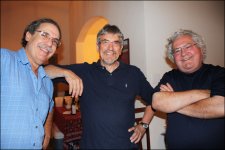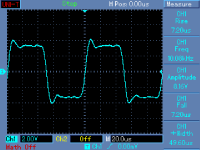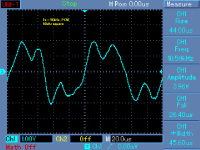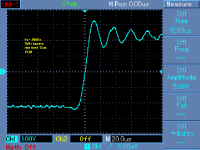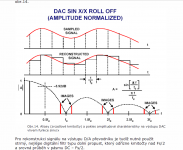Hi,
First, last time I worked on and/or designed a tapehead playback Amplifier there was no filter for the AC Bias during recording. There is such a filter to stop this RF Bias leaking into the recording Amplifier (where it can cause interesting problems, especially in the common looped feedback systems).
With Studio machines at 30ips and modern heads there is not much of a limit for high frequency response, the biggest issue is the playback side where Tape Head Amp's encounter similar issues as MM Cartridges in that the inductance causes a drooping high end which is normally corrected by using a parallel resonance circuit.
If the electronics are correctly designed and aligned and the tape heads are correctly aligned then Tape has no issues with frequency response flatness to better than 1dB and bandwidth >> 20-20K.
Noise depends on tape formulation and width of track, the classic 1/4Inch "halftrack" had quite low noise.
Distortion is an issue with analogue systems vs. digital. Most (but not all) analogue systems have monotonic distortion that is low order dominant (Class B Amplifiers are one of the key exceptions) and in this mirror the way the human hearing works.
In many cases such systems can be subjectively entirely transparent, despite having THD of several percent on peaks (see also Geddes and Geddes/Lee on Distortion). Common "High Fidelity" Loudspeakers are strong case point.
Digital Systems and Class B (also Class D) audio systems share a common characteristic, namely that their distortion is inverse monotonic, often the non-linearity function is also more complex (leading to more higher products.
So simply stating that an analogue system has more distortion is a little misleading. It would require to apply a suitable audibility weighting Metric to the distortion at different levels to be able to conclude anything at least where AUDIBILITY is of concern...
The issues around the limitations of FFT as tool to investigate "nonharmonic" (that is "fuzzy") distortion are of course not addressed with any of this...
Ciao T
analog tape has a AC bias of up to a few 100 kHz which also has to be removed with a filter - but tape head gap and tape speed are limits too - there is simply no cmparison possible if you want modern ADC levels of S/N, distortion and frequency response flatness - tape is objectively worse in all of these
First, last time I worked on and/or designed a tapehead playback Amplifier there was no filter for the AC Bias during recording. There is such a filter to stop this RF Bias leaking into the recording Amplifier (where it can cause interesting problems, especially in the common looped feedback systems).
With Studio machines at 30ips and modern heads there is not much of a limit for high frequency response, the biggest issue is the playback side where Tape Head Amp's encounter similar issues as MM Cartridges in that the inductance causes a drooping high end which is normally corrected by using a parallel resonance circuit.
If the electronics are correctly designed and aligned and the tape heads are correctly aligned then Tape has no issues with frequency response flatness to better than 1dB and bandwidth >> 20-20K.
Noise depends on tape formulation and width of track, the classic 1/4Inch "halftrack" had quite low noise.
Distortion is an issue with analogue systems vs. digital. Most (but not all) analogue systems have monotonic distortion that is low order dominant (Class B Amplifiers are one of the key exceptions) and in this mirror the way the human hearing works.
In many cases such systems can be subjectively entirely transparent, despite having THD of several percent on peaks (see also Geddes and Geddes/Lee on Distortion). Common "High Fidelity" Loudspeakers are strong case point.
Digital Systems and Class B (also Class D) audio systems share a common characteristic, namely that their distortion is inverse monotonic, often the non-linearity function is also more complex (leading to more higher products.
So simply stating that an analogue system has more distortion is a little misleading. It would require to apply a suitable audibility weighting Metric to the distortion at different levels to be able to conclude anything at least where AUDIBILITY is of concern...
The issues around the limitations of FFT as tool to investigate "nonharmonic" (that is "fuzzy") distortion are of course not addressed with any of this...
Ciao T
... and ... but ... also ... there is Dolby HR, which dynamically modulates the bias signal. Thus, you end up with "noise" that is correlated to the signal, and might arguably be harder to remove than constant bias. Dolby HR was consumer level, though, and I do not know whether the later Dolby S used similar dynamic bias in its semi-professional applications."analog tape has a AC bias of up to a few 100 kHz which also has to be removed with a filter"
Always something new.
i.e. tape can have a lot of complex noise on it.
Scott,
Let's talk instrumentation, do you have Bekessy hearing test plots for all of the participants? Did you test for legal and or illegal stimulants? Do you have full TEF plots of the room for each listening position? TEF plots of the actual music before and after? Were all of the listeners blindfolded?
Come on listening is a personal experience. Most folks today are fine with MP3. Yet few seriously argue it is the best method of reproduction. If you tell me it was great, I have no problems believing you. But if you tell me it was perfection, well you know!
Ed, would we lie to you??
(Photo credit: Cynthia Wenslow).
jan
Attachments
Hi,
Note, it AMPLITUDE modulates the Bias. Not Frequency Modulation. And there was a switch to turn Dolby etc. off. As a rule, most people I knew during those days ran with noise reduction OFF and the VU (Virtually Useless) meters pegging a lot.
Also, again, the Bias is normally so high in frequency, it does not show up during replay with nothing more fancy than a 2nd order filter...
If we want to go on about noises, DMM Records also had extra high frequency "bias" which made cutting into metal easier...
Ciao T
... and ... but ... also ... there is Dolby HR, which dynamically modulates the bias signal.
Note, it AMPLITUDE modulates the Bias. Not Frequency Modulation. And there was a switch to turn Dolby etc. off. As a rule, most people I knew during those days ran with noise reduction OFF and the VU (Virtually Useless) meters pegging a lot.
Also, again, the Bias is normally so high in frequency, it does not show up during replay with nothing more fancy than a 2nd order filter...
If we want to go on about noises, DMM Records also had extra high frequency "bias" which made cutting into metal easier...
Ciao T
Sorry if I've come in late and missed the equivalent 10 kHz tests from 192 kHz PCM, but my first inclination is to compare SACD v. PCM192 v. 30 ips tape, all with the same test. Again, I'm not asking for brand new tests, but it would have been nice to see the graphs side-by-side.
Currently I only have 96kHz PCM with CS4382 DAC. The digital filter is not a "brickwall" type. 10kHz square is not nice (see plots, do not read risetime from this plot as SW is unable to calculate it from this curve), with rise time about 12us (another plot, 1kHz repetition freq). Comparison with SACD shown.
There is a paper by Reefman and Nuijten (AES 110th Convention), they show a comparison of impulse responses of DSD, 192kHz PCM, 96kHz PCM ...
Attachments
Last edited:
I think that there is a good deal of 'prejudice' about analog tape recording. What is REALLY important is what analog tape sounds like, when it is done to the highest standards at the time of recording. This actually goes back to the 1950's, when some recordings made then are still remarkable today. Let's just say that IF we can bring back an event that was recorded, let's say, in 1957, and it can be almost like we were there, then somebody made a good analog recording with the best equipment at the time. Of course, most recordings will not qualify for that honor. Yet it was possible.
Wow and flutter can be virtually not a problem, bias frequencies can rise to 450KHz and higher. Track widths can be over .2 in, rather than .04 in or so. Tape speed can be as high as 30ips, rather than 71/2 or 15ips, yet some 15 ips recordings can be pretty good.
When these recordings, the best of them, are compared to CD recordings, often the analog recording is as good or BETTER than the CD recording, even made at the same time. This is a subjective assessment. DSD, or SACD, 24-96K or faster digital, CAN be very competitive, yet it still needs work to make it virtually perfect. That is what is happening today.
Wow and flutter can be virtually not a problem, bias frequencies can rise to 450KHz and higher. Track widths can be over .2 in, rather than .04 in or so. Tape speed can be as high as 30ips, rather than 71/2 or 15ips, yet some 15 ips recordings can be pretty good.
When these recordings, the best of them, are compared to CD recordings, often the analog recording is as good or BETTER than the CD recording, even made at the same time. This is a subjective assessment. DSD, or SACD, 24-96K or faster digital, CAN be very competitive, yet it still needs work to make it virtually perfect. That is what is happening today.
Not quite true. It is the anti-aliasing filter in the record chain which is truly inevitable. The image filter in playback is only necessary if you want to accurately reproduce the signal found after the anti-aliasing filter. If you are happy with a rough approximation to that signal, then a simpler filter (or no filter) can be used at the playback end.PMA said:I should mention that sharp DIGITAL filter with cut-off frequency below 22.05 kHz is an INEVITABLE part of CD 44.1kHz playback, even if there is an oversampling! Oversampling only allows for lower order ANALOG filter. The digital filter is inevitable for the reason to suppress aliases in audio band.
Some people prefer this sound; I suspect this is because the images just above 22kHz sound similar to (or better than?) the genuine signal just below 22kHz. We can't distinguish pitch at those frequencies, but those who can detect the presence of such signals may be able to respond to envelope and timing and this will be the same for the genuine signal and the image. Fortunately, the images from stronger lower frequency signals (at 44.1-f) are both higher up (and so less likely to be audible) and suppressed by the sinc frequency response caused by the DAC. Otherwise we would hear all sorts of anharmonic distortion!
Distortion is an issue with analogue systems vs. digital. Most (but not all) analogue systems have monotonic distortion that is low order dominant (Class B Amplifiers are one of the key exceptions) and in this mirror the way the human hearing works.
In many cases such systems can be subjectively entirely transparent, despite having THD of several percent on peaks (see also Geddes and Geddes/Lee on Distortion). Common "High Fidelity" Loudspeakers are strong case point.
Digital Systems and Class B (also Class D) audio systems share a common characteristic, namely that their distortion is inverse monotonic, often the non-linearity function is also more complex (leading to more higher products.
So simply stating that an analogue system has more distortion is a little misleading. It would require to apply a suitable audibility weighting Metric to the distortion at different levels to be able to conclude anything at least where AUDIBILITY is of concern...
Hi Thorsten,
There is an ancient saying in my country: "The whole teaching (or the whole Bible) on one leg (summarized)".
To my view, your above quote fits that saying.
Not quite true. It is the anti-aliasing filter in the record chain which is truly inevitable. The image filter in playback is only necessary if you want to accurately reproduce the signal found after the anti-aliasing filter. If you are happy with a rough approximation to that signal, then a simpler filter (or no filter) can be used at the playback end.
Some people prefer this sound; <snip>
I have a more cynical take on this, I think what most people are objecting to is very poorly executed analog design post D/A conversion. Possibly the path of least audio harm is the one where the signal passes through the fewest parts possible despite the potential issue of ultrasonic images folding back into the audio band due to intermodulation downstream.
I have a more cynical take on this, I think what most people are objecting to is very poorly executed analog design post D/A conversion. Possibly the path of least audio harm is the one where the signal passes through the fewest parts possible despite the potential issue of ultrasonic images folding back into the audio band due to intermodulation downstream.
I'd say that the analogue output section of any player or DAC is of critical impact on the overall sound quality. Fewest parts possible is but one thing, however whether the analogue section is built of ICs, discrete SS or tubes and the topology and parts selection also matter.
So, possibly there is no one solution that is a "cure all".
So, possibly there is no one solution that is a "cure all".
Certainly agree, but there are better solutions than those typically employed.
Not quite true. It is the anti-aliasing filter in the record chain which is truly inevitable. The image filter in playback is only necessary if you want to accurately reproduce the signal found after the anti-aliasing filter. If you are happy with a rough approximation to that signal, then a simpler filter (or no filter) can be used at the playback end.
Let's separate in two cases.
1) In case of oversampling, the digital interpolation filter must cut everything above 22.05kHz, based on principle of oversampling.
2) If no oversampling is used, the brickwall digital filter is needed to make flat amplitude response in audio band. Without such filter, there is -3.92dB at half sampling frequency. And, you create mirror frequencies, that may lay inside audio band.
Attachments
Certainly agree, but there are better solutions than those typically employed.
Of course, else, all would love all Players and all DAC converters…
Ed, would we lie to you??
jan
Jan,
The question is. "Has your perception been distorted?" 🙂
The guy on the left looks more like a cousin than my real cousins do!
Let's separate in two cases.
1) In case of oversampling, the digital interpolation filter must cut everything above 22.05kHz, based on principle of oversampling.
2) If no oversampling is used, the brickwall digital filter is needed to make flat amplitude response in audio band. Without such filter, there is -3.92dB at half sampling frequency. And, you create mirror frequencies, that may lay inside audio band.
Pavel,
I like the image posted but the output sine wave needs to be right shifted by one time period! Is the book a translated version or original?
You are mixing together two issues here. Brickwall filtering (to eliminate images) and sinc-compensation filtering (to compensate for the DAC sinc response) are two separate issues, although they may be addressed in the same filter. 'Mirror' frequencies may arise from analogue circuitry nonlinearity if the brickwall filtering is inadequate.PMA said:If no oversampling is used, the brickwall digital filter is needed to make flat amplitude response in audio band. Without such filter, there is -3.92dB at half sampling frequency. And, you create mirror frequencies, that may lay inside audio band.
The guy on the left looks more like a cousin than my real cousins do!
I think I've just been dissed. 😀
Of course, else, all would love all Players and all DAC converters…
I have now verified that a $54 Sandisk mp3 player sounds inferior to SY's DAC even at 320K. Now to move up the cost ladder. I have to admit my HD600's directly into my stock Dell E6500 would require a careful DBT.
- Status
- Not open for further replies.
- Home
- Member Areas
- The Lounge
- John Curl's Blowtorch preamplifier part II
